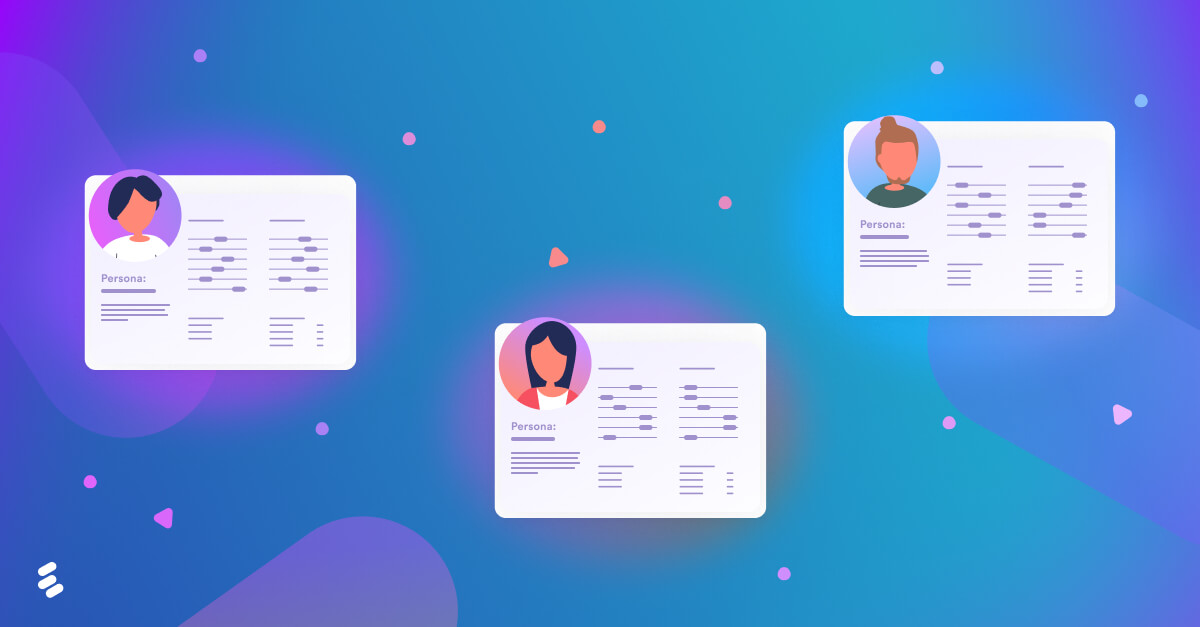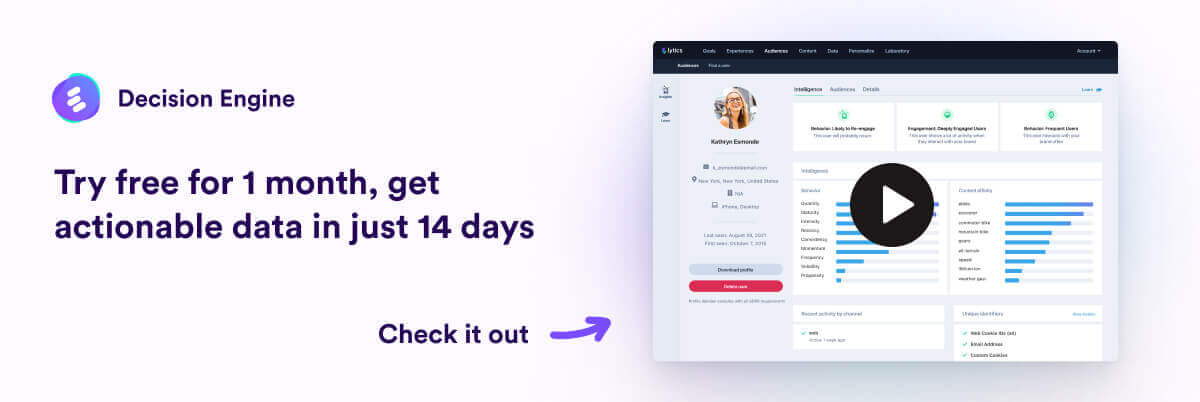How persona segmentation can boost your marketing efforts
February 22, 2022

For modern companies living in the digital age, persona segmentation has become a common and necessary practice. Let’s talk about how persona segmentation can help marketing teams achieve precision in their decision making and boost their overall marketing efforts.
Persona segmentation vs. personalization: Why it matters
You’ve probably heard other marketers use segmentation and personalization interchangeably. However, they’re two different strategies with entirely different meanings. When your marketing team discusses the goals and execution of a campaign, it’s crucial that everyone’s on the same page when it comes to segmentation vs. personalization.
Persona segmentation
Let’s start by defining persona segmentation. It’s a principal strategy that’s behind basically every successful campaign that involves identifying and grouping similar customers together. While this is a very broad definition and there’s much more to it, we’ll delve more into persona segmentation after talking about personalization.
Personalization
There’s one big difference when it comes to persona segmentation vs. personalization: Personalization is about one specific individual in a segment. It involves determining how your brand can provide the solution to a certain customer’s pain point. Personalization should occur every time a customer interacts with your brand, no matter the channel.
A guide to buyer persona segmentation
So, your marketing team spent their time creating detailed buyer personas—what do you do with them now? The answer is persona segmentation. Follow these three steps to humanize, find, and target your personas in the most effective way.
1. Segmenting your personas
Marketing teams generally create sets of buyer personas to add context to and help better understand their customers. Personas should be extremely detailed and contain data on a variety of customer issues, including their pain points, buying motivation, and purchasing authority. But to make actionable personas that are easy and desirable to target, you’ll want to map them to the information in your customer data platform (CDP).
This can also present you with opportunities to enrich the customer data that you already have. One technique that you can use to gain more data directly from your customers is to use a strategy called progressive profiling. This entails providing your customers with a new form to fill out each time they visit your site, and each time the form asks for incrementally more info from them. This strategy provides your marketing team with the data they need to better target and tailor how they approach the customer and typically results in higher conversion rates compared to shorter forms.
2. Scoring your segments
Once you can accurately identify the buyer personas in your CDP or other database, you’ll want to start developing a scoring methodology. The two attributes most commonly used to score segments are:
- Demographic data: company size, industry, location, etc.
- Behavioral data: website engagement, registration, purchases, etc.
Different personas are going to want different things from your marketing team. For example, decision makers are more likely to interact with downloadable assets (like an e-book) that focus on increasing ROI. On the other hand, casual personas are more likely to show interest in content like blog posts and tutorials that focus on day-to-day productivity.
So, depending on which personas you’re focusing on, you’ll want to score the relevant content accordingly—if you’re focusing on decision makers, you’ll prioritize downloadable assets that will benefit them most. It’s also good practice to assign a higher score to personas that are further down your sales funnel based on their actions, like scheduling a demo.
If you’re using a CDP like Lytics, it’s easy to set up a robust behavioral scoring system to automatically move your customers in and out of different segments as their activities change.
3. Applying your segments
Now, it’s time to target and engage your customers. After segmenting your personas, there are a few different channels you can use to reach your target audience:
- Display advertising: One of the most common channels for targeting your buyer persona segments is through display advertising on platforms like LinkedIn, Facebook, and other social media sites. It’s become more precise over the years, allowing marketers to not only target by using firmographic and behavioral data but also to accurately measure the results.
- Content syndication: Because marketers are able to implement intent data with attributes like demographic and behavioral information, content syndication allows them to drive engagement and generate conversions. Technology in this space makes it easier to find what your customers want to see and when they want to see it.
- Email marketing: Using dynamic content to achieve personalization in your email marketing campaign is a great way to increase conversions and engagement with your persona segments. Marketing automation platforms and customer data platforms can help you easily set up persona segmentations and target those groups with personalized email strategies.
Persona segmentation strategies are unique to each business depending on their industry, functions, prospects, and so on. Creating buyer personas is only the first step, and segmenting those personas is the crucial second step. You can use these three guidelines to segment, score, and apply your persona segmentations to foster an integrated marketing approach to achieve higher-quality leads and more conversions.
Six use cases: Benefits & examples of persona segmentation
Now let’s look at some different ways that you can use persona segmentation and how those strategies can help boost your overall marketing efforts.
1. Segment personas and the customer lifecycle
Your persona segmentations all have different levels of engagement and commitment to your brand. So, it’s important to identify those who are ideal early adopters, who might slip away quickly, which users are most likely to stay with you for the long term, and those who might need an extra push to pick up your product. Understanding how your personas make decisions and how they feel about your brand and product is crucial. Creating and segmenting personas for customers in different stages of their lifecycle can help you adapt to those variations and focus on the most ideal prospects.
2. Reach the most valuable segments
Customers in your persona segments likely expect different things from your company. Different users will use your product for different purposes, and it’s crucial to adapt to their needs. For example, more casual users might only require a few basic features, while professional teams using your products will need highly relevant features to their industry, wants, and needs. Creating persona segmentations for different categories of customers will make building out the right features to reach your most valuable segments easier.
3. Choose which channels to focus on
Every marketer knows that taking an omnichannel approach is necessary to reach your audience. Persona segmentation helps choose which channels are the best to focus on—some users are best reached through social networks, while others may be more likely to interact with a banner ad, email, or print campaign. Using your persona segments, you can determine how best to reach different groups within your target audience. A/B testing complements your persona segmentation efforts to find the best copy, design, and distribution method for your campaigns.
4. Persona segmentation and customer experience
Persona segmentation is also extremely helpful in understanding the various implications of your buyer personas and determining which segments are taking up the majority of your time and resources—a concern for many customer experience teams. Ideally, for most campaigns, you’ll want to spend more time on highly engaged customers and minimal time on high volumes of people who aren’t actively engaging with your brand. In any case, persona segmentation can help identify which customers to turn your focus to.
5. Pricing model optimization
Defining your audience and the persona segments within it is an essential part of determining your product’s pricing model. Understanding those segments in your audience helps you make better estimates in areas like your cost per acquisition. You’re likely to see more cost resistance from smaller subgroups of your persona segmentations than you are with customers who already engage with you. Optimizing your pricing model is a huge process, and using persona segmentation to group your customers by their financial potential can help plan for growth and determine the best margins for your product.
6. Predict users’ needs and wants
Unless your product is highly specialized, it’s likely that you have a variety of people interacting with it. And in some cases, it might be a connecting agent between different customers. This is important to understand, especially for UX teams, as each type of user will have different goals and crave a different experience. For example, many SaaS products have various user roles (administrators, editors, viewers, etc.), and they all use the same platform but for different reasons. Creating and using multiple persona segmentations helps predict your users’ wants and needs throughout each group and determine which users need to access which features.
Create and segment personas: How Lytics can boost your marketing ROI
Anyone can create and segment personas. The real challenge that marketers face is targeting the right personas within the right segments.
With Lytics, you can:
- Build better persona segmentations. Lytics makes it easy—start with pre-defined audiences, and the platform will automatically update your persona segments as customers either meet or no longer meet the criteria you set.
- Make better marketing decisions. Using machine learning, Lytics analyzes customer data to better segment your users based on their expected behavior and interests, allowing you to narrowly target the right segments through the right channels.
- Leverage audience suppression. Stop wasting time and ad spend on the segments that aren’t likely to be receptive to certain campaigns. Reduce cost per acquisition and improve conversion rates by removing ad impressions from those who are unlikely to convert.
Learn more about how Lytics helps marketers build better audiences and persona segmentations, and start your 30-day free trial today—get real, actionable data to boost your marketing efforts.



